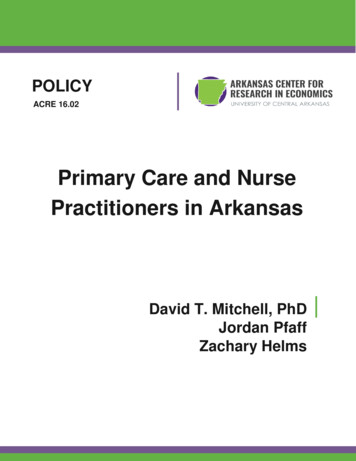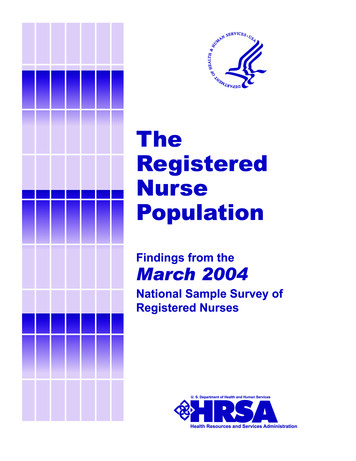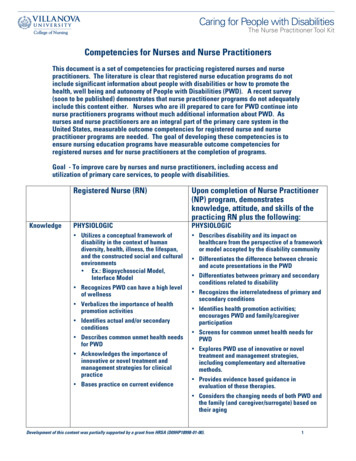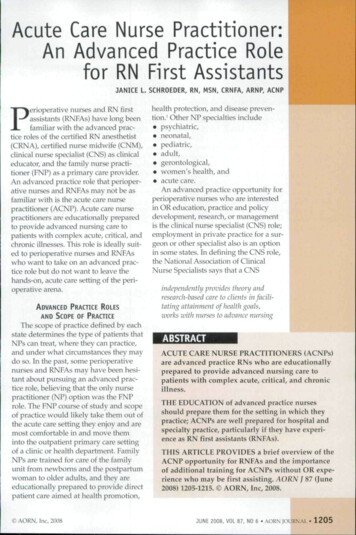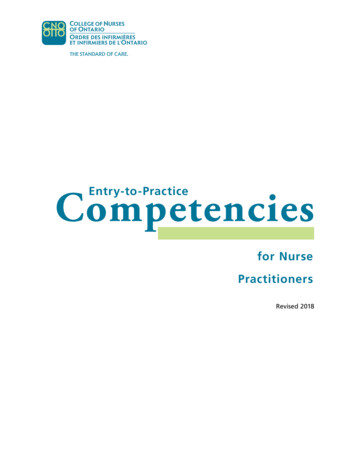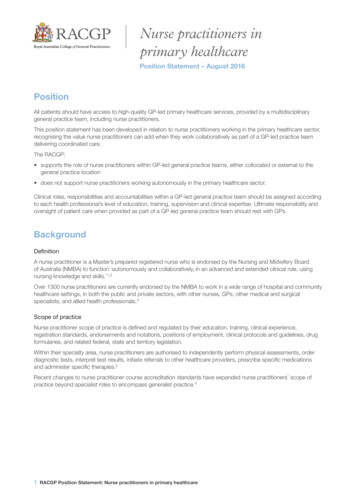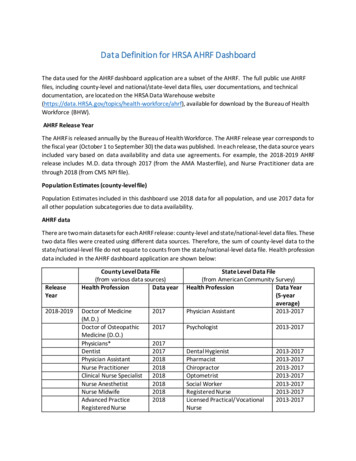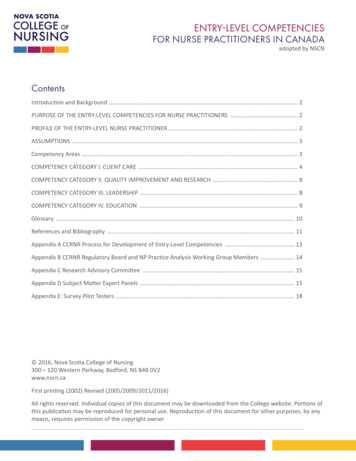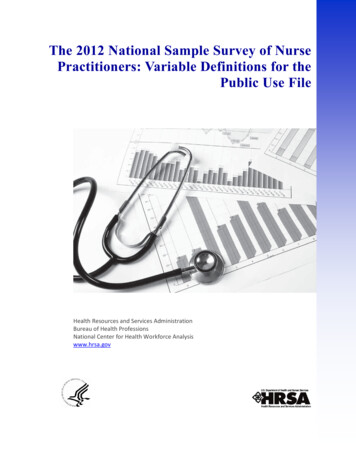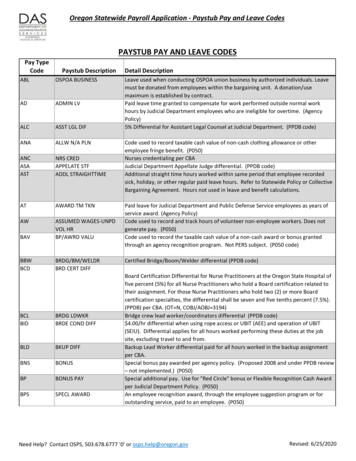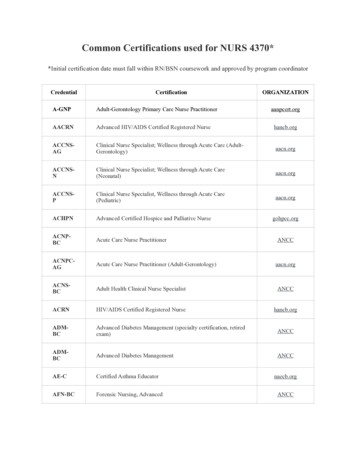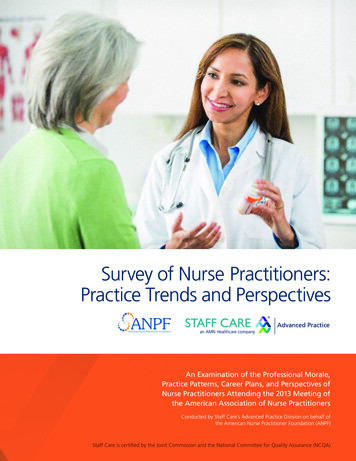
Transcription
Survey of Nurse Practitioners:Practice Trends and PerspectivesAdvanced PracticeAn Examination of the Professional Morale,Practice Patterns, Career Plans, and Perspectives ofNurse Practitioners Attending the 2013 Meeting ofthe American Association of Nurse PractitionersConducted by Staff Care’s Advanced Practice Division on behalf ofthe American Nurse Practitioner Foundation (ANPF)Staff Care is certified by the Joint Commission and the National Committee for Quality Assurance (NCQA)
Survey of NursePractitioners: PracticeTrends and PerspectivesOverview/ MethodologyKey FindingsQuestions Asked & Responses ReceivedTrends and ObservationsConclusion2361217Advanced PracticeFor additional information aboutthis survey contact:Phillip Miller(800) 876-0500phil.miller@amnhealthcare.com5001 Statesman DriveIrving, Texas 75063www.staffcare.com
OverviewMethodologyStaff Care is a leading healthcare staffing firmStaff Care conducted the 2013 Survey of Nursespecializing in matching temporary (i.e., locum tenens)Practitioners at the 2013 meeting of the Americanphysicians, nurse practitioners, certified registered nurseAssociation of Nurse Practitioners held June 19-22, 2013anesthetists (CRNAs), physician assistants, and dentistsin Las Vegas, Nevada. The survey was made availablewith hospitals, medical groups, government facilities,to those visiting Staff Care’s booth and could be takencommunity health centers and other healthcareanonymously. Those NPs who wished to obtain a copyorganizations nationwide. Established in 1992, Staffof survey results included their contact information onCare is a company of AMN Healthcare, the leaderthe survey form. During the course of the AANP meeting,in innovative healthcare workforce solutions, and isStaff Care obtained 222 completed surveys from NPs incertified by the Joint Commission and by the Nationalattendance. The survey was self-selecting and includedCommittee for Quality Assurance (NCQA).only those NPs who attended the AANP meeting. ItThis report marks Staff Care’s Advanced Practiceof NPs who did not attend the meeting or those whoDivision’s first survey of nurse practitioners (NPs).attended but chose not to participate in the survey.therefore may not reflect the experiences and opinionsThe purpose of the survey is to reflect the currentmorale levels, career plans, practice metrics andthe professional perspectives of nurse practitionersattending the 2013 meeting of the AmericanAssociation of Nurse Practitioners (AANP).The survey was conducted by Staff Care in partnershipwith The American Nurse Practitioner Foundation(ANPF). The American Nurse Practitioner Foundation(ANPF) provides the leadership, innovation andeducational opportunities required for nursepractitioners to meet the healthcare challenges of the21st century global community. The ANPF supports NPeducation, enables innovative research and provides thetools and resources to develop practice-based, datadriven solutions to public health problems. ANPF seeksto enrich the opportunities for the next generationof NP leaders to meet the global challenges facinghealthcare today.2013 Survey of Nurse Practitioners2
Key FindingsStaff Care’s Advanced Practice Division’s 2013 Survey ofNurse Practitioners highlights several points of interestregarding the practice patterns, morale levels and careerplans of today’s nurse practitioners.Key Findings Of The Survey Include:*NPs are overwhelmingly positive about theirprofession. All 222 of those respondingto the survey (100%) indicated they havepositive feelings about being an NPPositive A100Negative99% 1%222 100%RespondentsPositive*When asked to rate their professionalmorale, 98% of NPs surveyed said theirmorale was positive. Only 2% rated theirmorale as somewhat negative.PositiveNegative98%32013 Survey of Nurse Practitioners*Virtually all of those surveyed (99%) arepositive and optimistic about the futureof their profession. Fewer than 1% hadsomewhat negative feelings about thefuture of NPs.*When asked to rate the professional moraleof NPs they know, 97% of respondents saidthe morale of NPs they know is positive. Only3% rated the morale of NPs they know assomewhat negative.Positive2%Negative97%Negative3%
*NPs were virtually unanimous in statingthey would choose to be an NP again ifthey had their careers to do over. 96%would choose to be an NP, while only 4%would choose another field.964 A 4 96A96%Stay an NP4%Change fields*The majority of NPs (63%) said they do notplan to make a change in the next one tothree years. However, 35% plan to take oneor more steps that would likely reduce patientaccess to their services. These steps includeretiring, cutting back on hours, seeking a nonclinical job, or working part-time.63%100%80%No Change60%37%40%Make Changes20%0%*On average, NPs spend 25% of their timeon non-clinical paperwork25 75 A*NPs also were virtually unanimous in statingthey would recommend their professionto young people. 97% would recommendNP as a career to young people, while only3% would not.25%97%3%RecommendNot Recommend2013 Survey of Nurse Practitioners4
*The majority of NPs (81%) describe themselvesas overworked and overextended or are atfull capacity. Only 19% said they have time tosee more patients and assume more duties.100%80%60%40%20%0%81%Overworked/full capacity19%Have time*20% of NPs surveyed said they haveexperience working on a temporary(i.e., locum tenens) basis.20%*Just over half of NPs surveyed (51%) said thatthey lead the patient care team of whichthey are a member.51%Leaders of their team52013 Survey of Nurse Practitioners*When asked to rate the supply of NPsnationally, three quarters of NPs surveyed(75%) said there is a national shortage,while 23% said the supply is adequate.7525 A 25 75A75%23%Shortage in NationalSupplyNational Supplyis Adequate*10% indicated they plan to work locumtenens in the next 1-3 years.10% 1 percent
Questions Asked &Response Received1 What is your primary practice focus? (check all that erontological9%Pediatric5%Behavioral Health2%Women’s Health4%What is your board certification? (check all that apply)Acute Care NP10%Family NP73%Adult NP11%Family Psychiatric-Mental Health NP0%Adult Gerontology Acute Care NP2%Gerontological NP2%Adult Gerontology Primary Care NP2%Pediatric NP2%Adult Psychiatric-Mental Health NP0%Obstetric NP0%Diabetes Management – Advanced0%Neonatal NP0%Emergency NP2%2013 Survey of Nurse Practitioners6
345What is your primary scope of practice? (check all that apply)Diagnosis and management of both acute episodic and chronic conditions81%Emphasis on health promotion and disease prevention52%Services include but are not limited to ordering, conducting, supervising and interpretingdiagnostic studies, prescription of pharmacologic and none pharmacologic therapies49%Home health assessments10%Do you have experience in any of the following? (check all that apply)Vein harvesting2%Orthopedics29%Otolaryngology7%Urgent Care71%Electrophysiology4%PM&R6%Corrections8%Home Health21%In what state do you practice? NPs from 36 statescompleted the survey, including:VA, CA, SC, NY, IL, UT, PA, NV, DE, NC, IN, AK, ND, AZ, GA, FL, MS, WY, MT, NE, WA, OR,MO, NJ, IA, MN, ID, MI, OK, MD, KS, TX, OH, NM, ME, WI67What is your current clinical setting?Private Physician22%Veterans Administration4%Hospital Outpatient Setting19%Employed by a Community Health Center6%Hospital Inpatient Setting23%Extended/ Long-Term Care5%Medical Group10%College Health Service2%Hospital Emergency Department3%Independent NP1%Retail Clinic5%2013 Survey of Nurse Practitioners
7What is your age?8 What is your %50-5935%90 0%Male9%Female91%9 What was your salary in 2012?Average10 Do you lead the team in a patientcentered care delivery model? 95,80011 If yes, within the patient-centeredmodel, is your role:Yes51%a. Specific to one aspect of care31%No49%b. Involves overall care from patientpoint of entry to discharge69%12 Are you “invited to the table” inorganizational discussions regardingquality of care/patient satisfactionimprovement?13 Which best describes your feelingsabout being a nurse practitioner?Very Positive88%Yes82%Somewhat Positive/ Optimistic12%No18%Somewhat negative0%Very negative0%2013 Survey of Nurse Practitioners8
14 Which best describes how you feel about the future of your profession?Very positive/optimistic88%Somewhat negative/pessimistic0%Somewhat Positive/ Optimistic12%Very negative0%15 How would you rate the professional morale of nursepractitioners you know?Very Positive67%Somewhat negative3%Somewhat Positive30%Very Negative0%16 How would you rate your own professional morale?Very Positive79%Somewhat negative2%Somewhat Positive19%Very Negative0%17 If you had your career to do over, would you choose to be a nurse practitioner?Yes94%No6%18 Would you recommend nurse practitioner as a career to your childrenor other young people?Yes92013 Survey of Nurse Practitioners97%No3%
19 Have you ever worked on a temporary (locum tenens) basis?Yes20%80%No20 In the next one to three years, do you plan to (check all that apply):Continue as I am63%Work part-time12%Cut back on hours8%Work locum tenens10%Retire3%Seek additional training to obtain Ph.D9%Work independently10%Specialize (leave primary care)1%Relocate to another practice/community13%Close my practice to new patients0%Cut back on patients seen0%Work in a retail location4%Seek a non-clinical job2%Other9%21 How has passage of the Patient Protection and Affordable Care Act (PPACA/Health Reform) affected your feelings about the direction and future thenurse practitioner field?I am more positive57%I am less positive10%My feelings have not changed33%22 On average, how many hours do you work per 5037%91-1000%51-6013%101 or more0%Average hours worked per week: 44.82013 Survey of Nurse Practitioners10
23 Of these, how many hours do you work each week on NON-CLINICAL(paperwork) duties only?0-1057%41-501%11-2031%51-601%21-309%61 or more0%31-401%Average hours a week on paparwork: 1124 On average, how many patients do you see per day?0-1018%41-502%11-2049%51-600%21-3026%61 or more0%31-405%Average patients seen per day: 1725 Which of the following best describes your current situation?I am overextended andoverworked18%I am at full capacity63%I have time to see more patients andassume more duties19%26 How would you rate the current supply of nurse practitioners nationally?There is a shortage of nursepractitionersThere is an oversupply of nursepractitioners11 2013 Survey of Nurse Practitioners75%3%The current supply of nursepractitioners is adequate22%
Trends and ObservationsHealth care delivery models today are evolving away from a system in which individualSummary Highlights:practitioners direct and provide patient care to a more team based approach as exemplifiedby patient centered medical homes and accountable care organizations (ACOs). Nurse On average, NPs see 17patients per day On average, NPs spend25% of their time on nonclinical paperworkpractitioners comprise an increasingly important part of the expanding healthcare team,providing diagnosis, treatments and prescriptions in the hundreds of millions of patientencounters they handle per year.A nurse practitioner is an Advanced Practice Registered Nurse (APRN) who has completedgraduate-level education (either a Masters of Nursing or a Doctor of Nursing Practice). NPstreat both physical and mental conditions through comprehensive history taking, physicalexams, and ordering and interpreting diagnostic tests. NPs can diagnose disease and provideappropriate treatments for patients, including prescribing medications. In 18 states and theDistrict of Columbia, NPs can diagnose and treat patients and prescribe medications withouta physician’s involvement. In the remaining 32 states, a physician’s involvement is required forNPs to diagnose and treat patients or prescribe drugs, or both. In some of these states, thereare movements to increase the scope of practice of NPs.There are over 155,000 NPs practicing in the United States today, with an estimated 11,000completing training each year. NPs hold prescriptive privileges in all 50 states, though insome states they cannot prescribe controlled substances. Over 96% prescribe medications,averaging 20 prescriptions per day. About 96% of NPs are female and approximately 18% ofNPs practice in rural areas. Traditionally, NPs practicing independently have been paid at 85%of the rate Medicare pays to physicians for the same services, though the Affordable Care Act(ACA) increased Medicare reimbursement for NPs providing primary care by 10%. (Source:American Association of Nurse Practitioners).2013 Survey of Nurse Practitioners12
Close to 90% of NPs practice in primary care, whereSchool notes that while the number of NPs per populationphysician shortages are particularly acute. Accordingis growing, the number in primary care peaked severalto the Association of American Medical Colleges, thereyears ago and now is declining. Due to growing demand,will be a deficit of 46,000 primary care physicians byDr. Cooper projects a 20% deficit of NPs by 2025 (Source:2020, and the Department of Health and Human ServicesPhysician Shortage Isn’t the Only Looming One, Advance for(HHS) now designates approximately 6,000 Health CareNPs and PAs, July 28, 2011).Professionals Shortage Areas (HPSAs) for primary care inwhich some 55 million Americans live. Beginning in 2014,Because of their growing role, the morale of NPs, theirmillions of the currently uninsured will obtain healthpractice metrics and their practice plans are of increasedinsurance through the ACA, significantly increasingimportance when considered within the context of overalldemand for primary care and other services.healthcare workforce supply trends and emerging deliveryNPs are projected by some health care policy makers andSurvey of Nurse Practitioners: Trends and Perspectives,models. Staff Care’s Advanced Practice Division’s 2013advisers as a key to addressing the physician shortage inprovides insight into these issues, as is discussed in theprimary care. However, noted physician and advancedanalysis that follows.practitioner supply and utilization expert Richard “Buz”Cooper, M.D. of the University of Pennsylvania/WhartonHappy to Be HereNPs who completed the survey expressed a high degree ofprofessional satisfaction, particularly when compared tophysicians completing a similar survey. In the fall of 2012,Merritt Hawkins (which, like Staff Care, is a company ofAMN Healthcare) released a national survey of 13,575physicians that it completed on behalf of The PhysiciansFoundation (www.physiciansfoundation.com).Comparing responses to the two surveys is instructive.Below are several questions included in both surveys, withresponses from NPs and responses from physicians.13 2013 Survey of Nurse Practitioners
Which best describes your feelingsabout being in your profession?100%32%NPsPhysiciansWhich best describes your feelingsabout the future of your w would you rate the morale ofyour professional peers?97%20%NPsPhysiciansHow would you rate your own morale?3%98%80%42%2%NPs58%PhysiciansPositiveIf you had to do it over, would youchoose the same career?94%66%NPsPhysiciansNegativeNegativeWould you recommend yourprofession to your children or otheryoung people?6%97%34%42%3%NPs58%PhysiciansYesNo2013 Survey of Nurse Practitioners14
The reason for the stark contrast in these numbers canCare, Merritt Hawkins or other AMN Healthcare companies.broadly be attributed to the fact that while NPs see theirNPs also were virtually unanimously positive about theimportance, income and autonomy expanding, physiciansmorale of their peers, their own morale, the future ofsee these same professional attributes contracting in theirtheir profession, their choice of career, their willingness tofield.choose it again if given a chance, and their willingness torecommend their profession to young people.As the numbers above indicate, every NP completing thesurvey rated their feelings about being an NP positively,These highly unambiguous responses suggest that nursethe highest rate of positive feelings that have beenpractitioners are among the most professionally satisfiedrecorded by health care professionals surveyed by Staffclinicians in the healthcare workforce.Where to Now?NPs were asked what they plan to do in the next onethe great majority of NPs (81%) said that they are eitherto three years. The majority (63%) indicated they planoverextended and overworked or at full capacity. Onlyto continue practicing as they are. However, 35% said19% indicated they have time to see more patients andthey plan to take one or a combination of steps likely toassume more duties.reduce patient access to their services. These steps includecutting back on hours, retiring, seeking a non-clinical job,working part-time or working locum tenens.As has been observed among physicians (see A Survey ofAmerica’s Physicians, Practice Patterns and Perspectives,The Physicians Foundation/Merritt Hawkins, September,The reduction in full-time-equivalent (FTE) nurse2012), a significant number of NPs are seeking a work/lifepractitioners that would result should NPs cut back onbalance predicated on reduced patient loads, part-timehours, work part-time, or take other steps limiting patientschedules or working locum tenens. Also like physicians,access would come at a time when most NPs surveyedmany NPs are gravitating toward specialties and awaybelieve there is a national shortage of professionals infrom primary care. These trends may contribute to thetheir field. Three quarters of NPs responding to the surveyemerging shortage of NPs projected by Dr. Cooper, just(75%) indicated there is a national shortage of NPs, whileas similar trends among physicians have led to shortages22% characterized NP supply as adequate, and a smallin the physician workforce.minority (3%) indicated there is an oversupply of NPs.In addition, when asked about their current workload,15 2013 Survey of Nurse Practitioners
Going MobileA key signal that a provider shortage may be emerging in a clinical profession is given whenSummary Highlights:a growing number of providers in that profession embrace temporary (i.e., locum tenens)practice, and when demand for temporary clinicians increases. In Staff Care’s 2013 Survey 20% of NPs have locum tenensexperience 10% of NPs plan to work locumtenens in the next one to threeyearsof Temporary Physician Staffing Trends it was observed that while Staff Care received aminimal number of requests for locum tenens NPs three years ago, in the last 12 months,NPs and physician assistants (PAs) comprised 10% of all requests Staff Care received.Use of temporary providers generally is driven by the need to maintain services whilehard to find permanent candidates are being sought, and that is the case today withNPs. Temporary providers also commonly are used to address gaps in the staff created byturnover. As the numbers above indicate, a substantial number of NPs have either workedlocum tenens assignments in the past or are planning to do so in the future. Ten percentof NPs surveyed said they plan to work locum tenens in the next one to three years, while20% have worked on a locum tenens basis sometime in the past. Locum tenens NPs maybe needed both to address provider shortages and to address turnover, as 13% of NPssurveyed indicated they plan to relocate to another practice or community in the next oneto three years.Should the supply of NPs become more constricted, it can be anticipated that a growingpercentage of the NP workforce will become mobile – a trend that also has been observedamong nurses and physicians.2013 Survey of Nurse Practitioners16
Practice Scope and MetricsThe majority of NPs surveyed (81%) have a broad scopeHowever, of these hours, NPs spend an average of closeof practice that includes diagnosis and managementto 25% on non-clinical paperwork duties. This, in effect,of both acute episodic and chronic conditions. A barereduces the overall NP workforce by some 38,750 FTEs.majority (51%) indicated that they lead the care teamReducing NP paperwork duties by just a few percentagein a patient-centered delivery model, underscoringpoints would restore thousands of FTEs to the clinical rolesthe growing autonomy and influence of NPs in today’sfor which they were trained.evolving healthcare system. In addition, the great majority(82%) responded that they are “invited to the table” inThe great majority of NPs surveyed (92%) said they seeorganizational discussions regarding quality of care and11 or more patients per day, 48% said they see 11 topatient satisfaction.20 patients per day, 26% see 21 to 30 patients per dayand 7% see 31 or more patients per day. On average,When asked about the hours they work per week, onlyNPs surveyed see just over 17 patients per day. A rough8% of NPs indicated they work part-time schedules of 30estimate based on 142,000 FTE NPs (adjusting for thosehours or less, while 92% indicated they work at least 31who work part-time) seeing 17 patients per day whilehours a week and 61% said they work 41 hours or moreworking 48 weeks per year suggests NPs handle overper week. Overall, NPs responding to the survey work an575 million patient encounters annually. Though this is aaverage of 44.8 hours a week.general estimate, it does underscore the central role NPsplay in providing patient care in today’s healthcare system.ConclusionStaff Care’s Advanced Practice Division’s 2013 SurveyAmong these changes will be a move toward a moreof Nurse Practitioners: Practice Trends and Perspectives,mobile practice style, a trend that also has been observedwhile based on a limited, self-selected sample, stronglyin the registered nurse and physician workforce.suggests that nurse practitioners enjoy a high degreeof professional satisfaction and morale, particularlyThe survey further indicates that most NPs have a broadcompared to physicians.scope of practice, while many are the leaders of thecare team, underscoring their increased autonomy andIt indicates that, like physicians, many NPs are makingpractice changes that will reduce access to their servicesat a time when their services are in increasing demand.17 2013 Survey of Nurse Practitionersimportance in today’s evolving healthcare system.
An Educational ResourceStaff Care and AMN Healthcare are committed to providingsurvey data and other information of use to healthcare executives,physicians, policy makers and members of the media.AMN Healthcare offers speakers to address healthcare industrytrends in staffing, recruiting and finance. Topics include: Locum Tenens Strategies and TrendsClinical Workforce SolutionsEvolving Physician Staffing ModelsPhysician and Nurse Shortage Issues and TrendsNew Strategies for Healthcare StaffingHealthcare Reform and Workforce IssuesEconomic Forecasting for Clinical StaffingAllied Staffing ShortagesVendor ManagementRecruitment Process OutsourcingOther Topics Upon RequestFor more information or to schedule a speakingengagement, please contact:Phillip MillerPhil.Miller@amnhealthcare.com(800) 876-0500Advanced Practice5001 Statesman DriveIrving Texas 75063(800) 685-2272staffcare.com 2013 Staff Care SC 13-S001
2013 Survey of Nurse Practitioners2 Staff Care conducted the 2013 Survey of Nurse Practitioners at the 2013 meeting of the American Association of Nurse Practitioners held June 19-22, 2013 in Las Vegas, Nevada. The survey was made available to those visiting Staff Care's booth and could be taken anonymously. Those NPs who wished to obtain a copy
